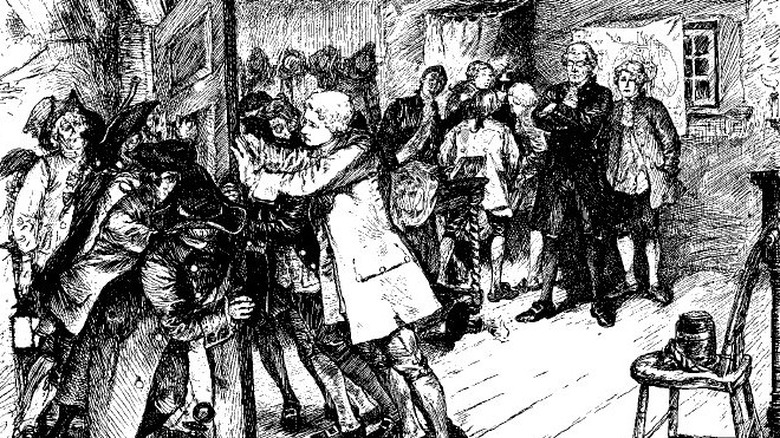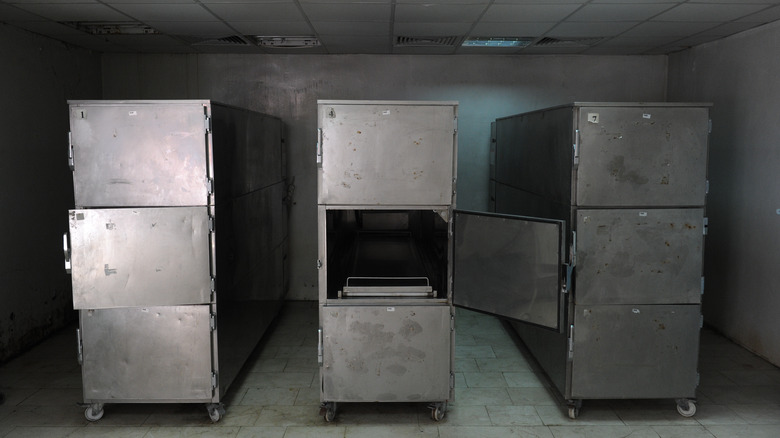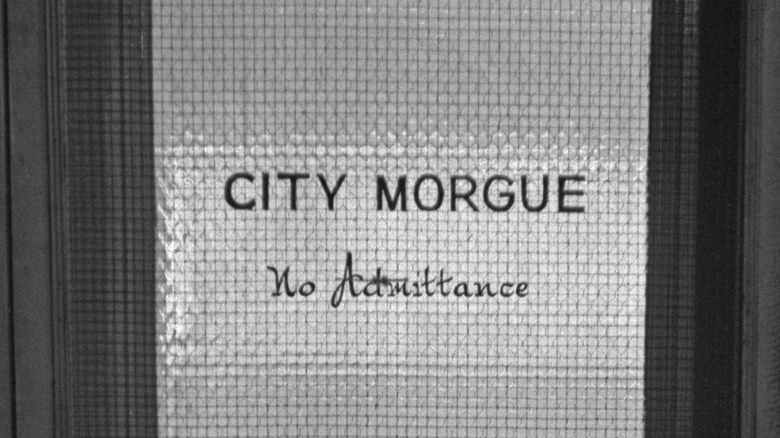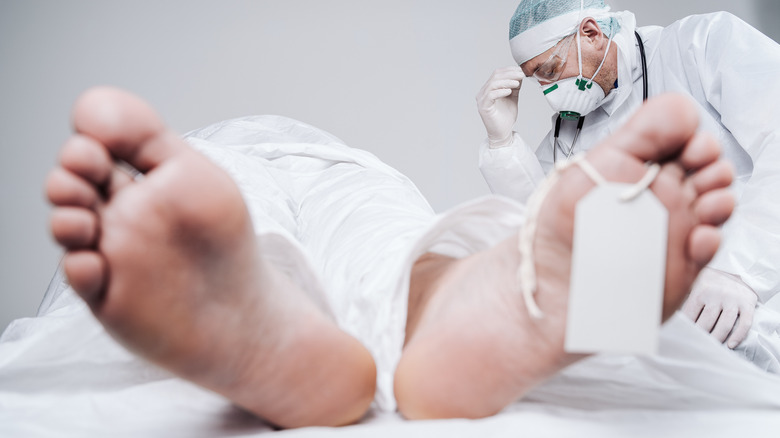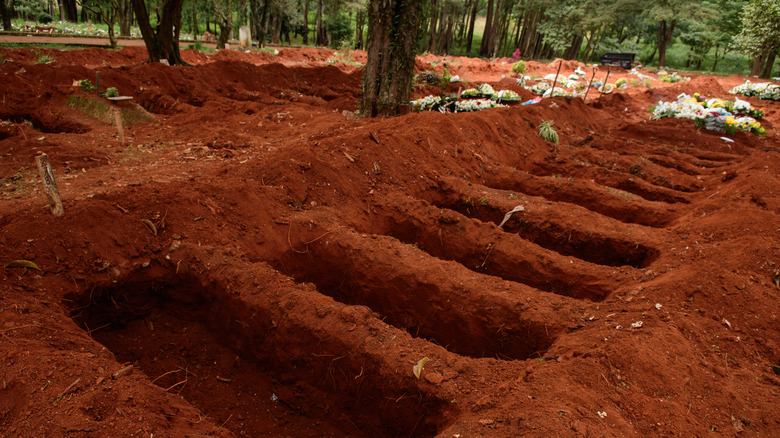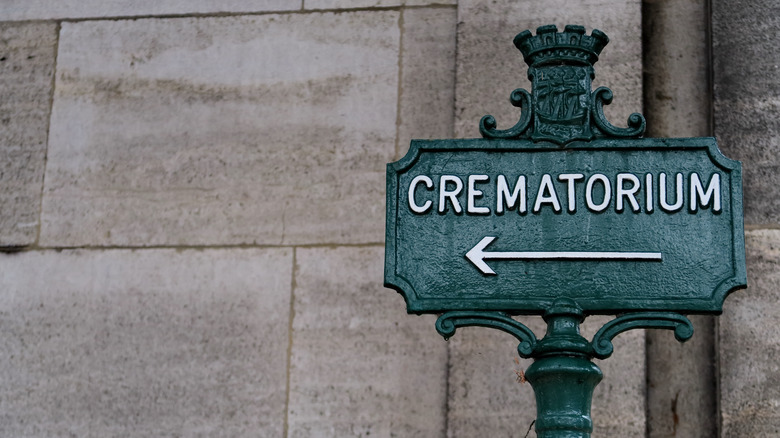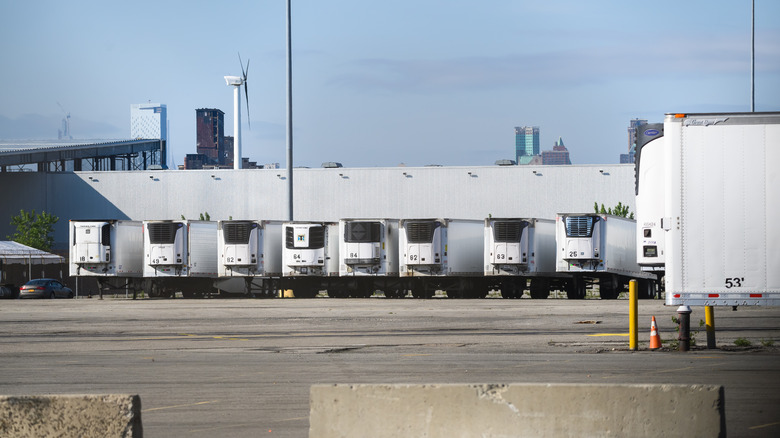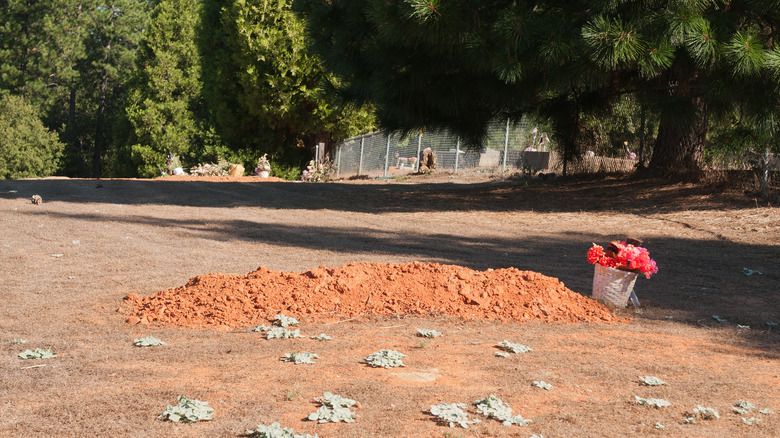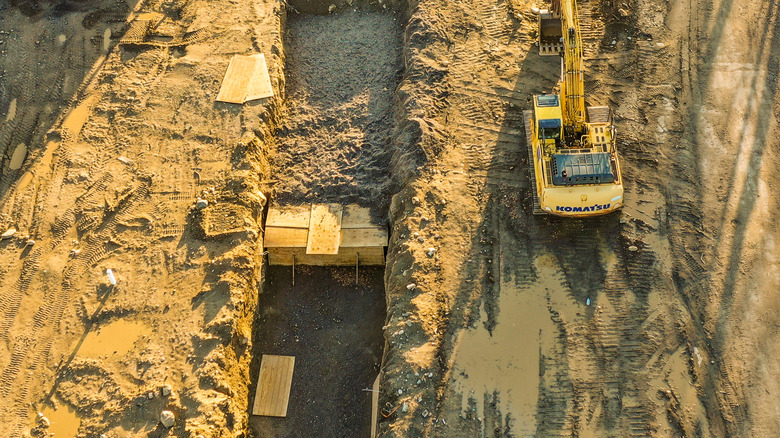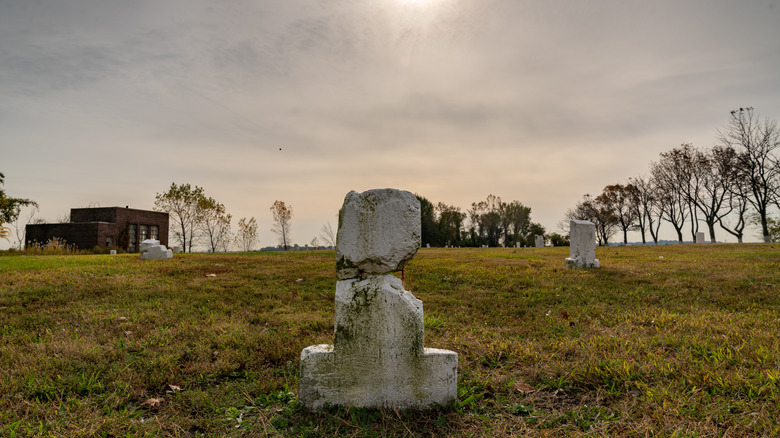What Happens When No One Claims A Dead Body?
Despite the name, unclaimed bodies aren't always technically unclaimed. Sometimes the person truly cannot be identified and no next of kin can be reached, but other times, the next of kin simply cannot afford to pay for a funeral. In the United States, in the event that the next of kin are unable to be reached or don't want to claim the remains, the responsibility of taking care of an unclaimed body falls onto the town, county, city, or state that is in possession of the deceased. But unfortunately, just because they're responsible for it doesn't mean that they always treat the unclaimed bodies with respect. In some instances, unclaimed bodies are treated with the most disrespect.
There are several options with what to do with unclaimed remains, ranging from medical uses to mass graves. Although in recent years the issue of consent has led some medical schools to stop taking unclaimed bodies, since there's no federal regulation on what to do with unclaimed remains, each state comes up with its laws and guidelines.
But no matter what happens in life, there will always be unclaimed bodies no matter how perfect the system may be. This is why every society has to address the issue of death and burial, in order to make sure that every single person is treated with respect. This is what happens when no one claims a dead body.
The history of unclaimed bodies
Before unclaimed bodies were designated as such, medical professionals frequently tried to get their hands on whatever bodies were available, unclaimed or not. Sometimes this involved stealing a body from a morgue or claiming the body of someone who was executed. Other times, it involved graverobbing.
Graverobbing led to New York's 1788 "Doctors' riot." Smithsonian Magazine writes that the uprising was directed at medical students who were graverobbing primarily from the cemeteries reserved for Black people. In February 1788, a group of free and enslaved Black people even submitted a petition in response to the graverobbing. However, they didn't ask for it to cease; instead, they requested that it be "conducted with the decency and propriety which the solemnity of such occasion requires." Unfortunately, the petition was ignored since many "were willing to turn a blind eye to grave-robbing as long as those bodies were poor and Black." It was only after the anatomy lab at the Hospital Society was burned down and several people were killed in April 1788 that New York City finally passed a law in 1789 that made graverobbing illegal, but allowed "the bodies of criminals to be used for dissection," according to JAMA.
Meanwhile, in the United Kingdom, graverobbing was put to an end with the Warburton Anatomy Act of 1832, inspired by William Burke and William Hare of Edinburgh, who went on a murder spree and killed 16 people after realizing the profit to be made from dead bodies.
Doctors and unclaimed bodies
In the 1830s, most states in the U.S. passed their own version of the Anatomy Act, which gave medical schools permission to dissect unclaimed bodies. However, "unclaimed" didn't always mean that there was no one to claim the body. Oftentimes, an unclaimed body just referred to someone whose family was "too poor to afford a burial," according to Talk Death. And as noted in "Anatomy's Use of Unclaimed Bodies," poor people weren't the only ones exploited by the Anatomy Acts: "The legitimacy of using unclaimed bodies has exposed vulnerable groups to dissection without their consent ... [including] the impoverished, the mentally ill, African Americans, slaves, and stigmatized groups during the Nazi era."
By the beginning of the 20th century, cadavers used by medical professionals "were supplied almost exclusively from unclaimed bodies." Eventually, public outcry led to a variety of legislation that banned the use of unclaimed bodies in several states. Some places, like medical schools in New York City, didn't ban the use of unclaimed bodies until 2016. Body farms also used to get bodies from unclaimed remains, but now they primarily rely on donations.
Even so, "unclaimed" often runs along a pretty thin line. In 2021, it was discovered that the human remains of two children, who'd died when the city of Philadelphia bombed the MOVE organization, had been taken and used by both UPenn and Princeton in their forensic anthropology classes. Meanwhile, the children's guardians were never asked for their consent.
No federal system
In the United States, there's no overarching federal rulebook for what to do with them, so each state has its own different rules for what happens to an unclaimed body. (The closest thing to a federal system is the Uniform Anatomy Gift Act, but that's only concerned with organ donations and transplants.)
According to The Oregonian, 14 states, as well as the District of Columbia, cover the cost of burial for unclaimed bodies. The other states "assign the responsibility to counties, townships, or cities; some jurisdictions put money aside every year, but most don't." And despite the fact that some states no longer allow their use anymore, "every state requires that unclaimed bodies first be offered to the largest medical school or a special office that distributes the bodies" to places that use them for educational purposes.
The Atlantic also notes that many states don't provide clear outlines on how to manage unclaimed bodies, so often "individual medical examiners [make] decision[s] about how to best deal with the bodies." And every year, roughly 1,000 sets of found human remains remain unidentified, and it's difficult to know exactly how many unidentified bodies there are in the United States. Because of this, and often limited funds, medical examiners will come up with a variety of ways to deal with unclaimed bodies.
Looking for next of kin
Most states will allow some time for the next of kin to be reached or to reach out, but depending on the state, they may only wait a few days before declaring a body to be unclaimed. In Oregon, for example, the law necessitates giving the authorities 10 days to look for next of kin. While in Texas, an unclaimed body can remain in the morgue for almost six months "before investigators feel all possibilities have been exhausted," reports Chron. After the first wave of COVID deaths in April 2020, New York City was overwhelmed with unclaimed bodies, and by November, the city was still "struggling to find the families of some 230 people." And according to "Who are the Unclaimed Dead?" in some states there are "laws regulating who is even eligible to claim or identify a decedent."
But even when the next of kin is found, that doesn't necessarily mean that the body will be claimed. Sometimes the next of kin will refuse the remains, which happened to one of the victims of the Pulse nightclub shooting. During the AIDS crisis, many families even refused the ashes of their relatives who had died from HIV/AIDS.
Other times, the next of kin simply won't be able to afford a funeral, so while they may take some of the deceased's belongings, they won't claim the body. As the Los Angeles Times writes, "even death is unaffordable."
$3,000 to bury
Burying a body is incredibly expensive. For most financially insecure people, they're simply not an option and for unclaimed bodies, it's rare for money to be available for a burial. It can cost between $3,000 to $7,000 to bury a body, and according to WWLP, the Department of Transitional Assistance only reimburses funeral directors $1,100. Plus, there's a catch: "In order to qualify for the reimbursement, [funeral directors] can't spend more than $3,500, which barely covers the cost of a basic burial."
The Atlantic reports that in the United States, "only 14 states devote money to funeral costs for unclaimed bodies." And since these costs were already barely enough to cover a single burial, they're nowhere close to being enough to cover "the actual volume of bodies that coroners and funeral directors face." Some states, like West Virginia, ran out of funds two years in a row, largely due to its overwhelmingly high rate of overdose deaths due to the opioid epidemic.
Unfortunately, space runs out pretty quickly. According to the Archdiocese of Chicago, in 2012, the Archdiocese of Chicago donated 300 graves from Mount Olivet Cemetery to the Cook County Morgue, which had become overcrowded. And in Chicago, unclaimed remains can be held as long as two years before a burial can be arranged.
Cremation is cheaper
Compared to a burial, cremations are significantly cheaper. WWLP reports that cremation runs closer to $500, but the issue is that for some states, it "requires a signature from next of kin." If the next of kin can't be reached, then the options are limited to burial or refrigerated storage. And according to The Atlantic, "some states don't allow coroners to request a cremation for fear that it could infringe on the deceased's religious values," since followers of religions such as Islam and Judaism don't condone cremation.
However, even cremated remains can add up and in places like South Carolina and Georgia, dozens of cremated remains can end up sitting in closets for years. According to the Los Angeles Times, Los Angeles County has a comparatively organized system. If a body isn't claimed after a month of passing, the body is cremated. The cremated remains are then kept for three years, giving time for the family to reach out, but if no relatives have reached out after three years, the cremated remains are all buried once a year at an "interfaith service."
Very Well Health writes that approximately 1% of all cremated remains every year are unclaimed, which doesn't sound like much, but comes to "over 15,000 sets of cremated human remains." In some states, like Massachusetts, funeral establishments are allowed to "scatter unclaimed cremated remains in a cemetery area designated for that purpose" if a year has passed and they haven't been claimed.
Waiting in refrigeration
If counties have to spend months looking or waiting for next of kin, then what happens to the body? In those cases, an unclaimed body will just be stored until the time limit passes or someone decides what to do with it. However, as USA Today notes, "small and rural counties may not have refrigeration space to store bodies for months." According to The Atlantic, in larger cities, unclaimed bodies will "float from office to office, home to home, refrigerated truck to refrigerated truck."
After Hurricane Katrina, hundreds of unclaimed victims were stored in refrigerated trailers for over a year in New Orleans, which had to be refueled every two days. In May 2021, ABC News reported that in New York City, hundreds of people who had died from coronavirus were still being stored in the refrigerated trucks that had been set up to serve as temporary morgues in the previous spring, many of whom remain unclaimed. And "between 500 and about 800 bodies have been kept in cold storage at any given time since April 2020."
But despite the strict regulations on how to store these decedents before providing them with some kind of burial, sometimes unclaimed bodies will be treated with disrespect and disregard. In Flint, Michigan, a funeral home was fined in 2016 for leaving unclaimed bodies "in the funeral home's garage."
Dumped in unmarked graves
Cities and towns have often resorted to the cheapest and easiest option to bury unclaimed bodies: unmarked mass graves. In 1995, the Associated Press reported that 68 victims of Chicago's heat wave were buried in an unmarked mass grave, 27 of whom were unclaimed bodies, while the rest simply had relatives that couldn't afford to pay for a funeral. In 2015, W.H. Bacon Funeral Home was criticized for dumping unclaimed bodies in unmarked graves "next to trash cans." In response, the funeral home claimed that it had "followed the terms of its contract," according to The Atlantic. And this practice definitely isn't new. Countless places in the United States, including Highland Park in New York, are built on top of unmarked mass graves.
In some places, like Detroit, volunteers come four times a year to visit where unclaimed bodies are buried in an unmarked mass grave at Canton Cemetery. "While these people aren't relatives—they likely never knew the deceased—they come because they believe no one should leave this world alone," writes Click on Detroit.
Los Angeles has been burying its unclaimed bodies in a mass grave "at the corner of 1st and Lorena streets in Boyle Heights formerly known as the Los Angeles County Crematorium Cemetery" for over 120 years, according to Curbed. And in New York City, one of the most famous mass graves is the "cemetery" on Hart Island, which has been used for decades for the burial of unclaimed bodies.
The history of Hart Island
During the Civil War, Hart Island was used as a training ground for Black Union soldiers, and was later turned into a prisoner-of-war camp for Confederate soldiers. But it wasn't until the 1860s that Hart Island started to be used for its current purpose. According to National Geographic, the first person buried at Hart Island was an unclaimed body. After dying of tuberculosis at the age of 24, Louisa Van Slyke was buried at Hart Island Cemetery since she had "no known family to claim her." The following year, the island was also used as a quarantine facility for yellow fever.
The largest wave of death would come in the 1980s and 1990s, when hundreds of people who died from AIDS were buried at Hart Island, since "funeral homes closed their doors to those who succumbed to the virus." But the first AIDS victims buried at Hart Island in 1985 couldn't escape the stigma against HIV/AIDS, even in death. Rather than a mass grave, "they were buried in an isolated area away from the remains of other individuals, in deep individual graves, under several feet of dirt instead of the typical three," according to the New York City Council.
In 2020, over 2,000 people were buried on Hart Island due to the COVID-19 pandemic. And according to The New York Times, it's estimated that one in 10 of New York City's COVID-19 victims may end up in a "potter's field."
How many unclaimed bodies are there?
In 2017, it was estimated that across all the morgues in the United States, there were approximately 40,000 unclaimed bodies being stored. However, both the opioid epidemic and the mismanagement of the COVID-19 pandemic have made that number skyrocket.
ABC News reports that in North Carolina in 2019, there were 83 unclaimed bodies, "the second-highest total in more than a decade (84 in 2017), and a 22% increase since 2008 (68)." Over half of the cases that the Office of the Chief Medical Examiner handles are related to drugs. And as funeral prices also skyrocket, more and more bodies are being left unclaimed because the deceased's relatives simply cannot afford the funeral expenses. In North Carolina, unclaimed remains are cremated, and after three years, the ashes are then "released in a 'dignified manner' off the North Carolina coast."
During the start of the COVID-19 pandemic in April 2020, according to NBC, New York City "shortened the amount of time it would hold unclaimed remains to 14 days before burying them on Hart Island." Although it was said at the time that this was a temporary measure, it's unlikely that the bodies are going to be moved. There are over 700 bodies still being kept in refrigerated trucks, and the city is considering burying them permanently on Hart Island as well.

